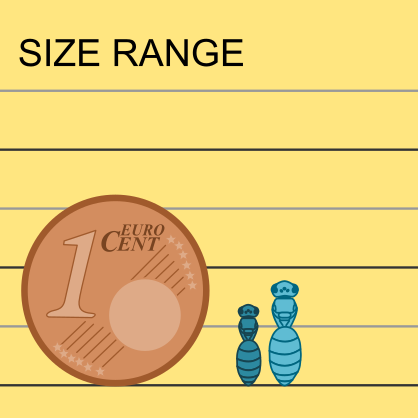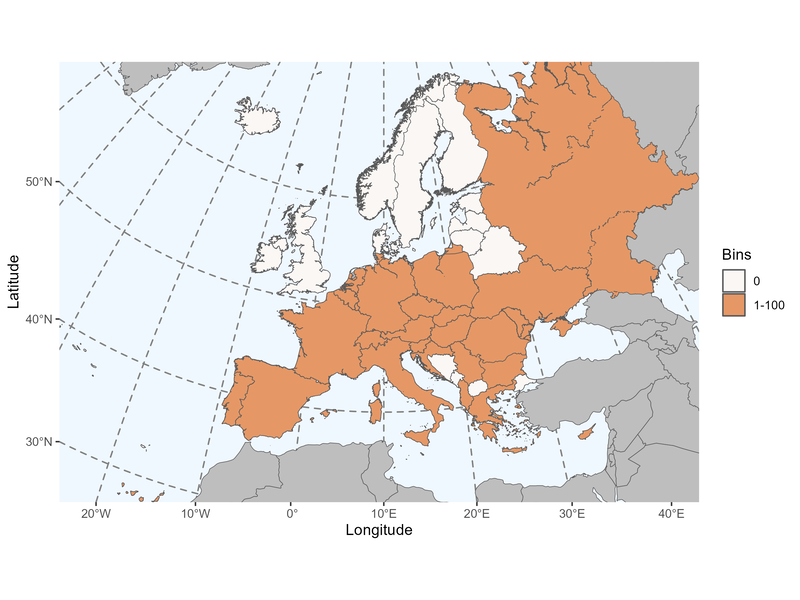Author: Friese, 1898
|
Type species: Anthidium limbiferum Morawitz, 1875, by original designation.
Subgenera: Exanthidium Pasteels, 1969; Pseudoanthidium s.str. Friese, 1898; Royanthidium Pasteels, 1969. Synonyms: Paranthidiellum Michener, 1948; Trachusa (Orientotrachusa) Gupta, 1993; Reanthidium Pasteels, 1969 |
Clade: Anthophila
Family: Megachilidae SubF: Megachilinae Tribe: Anthidiini |
|
Distinctive traits
|
Pictures of distinctive traits.
|
Morphologically close genera and how to distinguish them
Anthidium, Afranthidium & Icteranthidium species have axillae pointed or not produced away from the scutellum.
Anthidiellum, Rhodanthidium & Trachusa species have an arolium between their claws.
Stelis species may have pointed axillae, males have two widely separated apical teeth on their anterior and median tibiae and females have no ventral scopa.
Melitturga species have a truncated marginal cell, a second recurrent vein anteriorly connecting at the second submarginal cell, males with enlarged eyes and females without a ventral scopa.
- Pseudoanthidium - Anthidium, Afranthidium & Icteranthidium
Anthidium, Afranthidium & Icteranthidium species have axillae pointed or not produced away from the scutellum.
- Pseudoanthidium - Anthidiellum, Eoanthidium, Rhodanthidium & Trachusa
Anthidiellum, Rhodanthidium & Trachusa species have an arolium between their claws.
- Pseudoanthidium - Stelis
Stelis species may have pointed axillae, males have two widely separated apical teeth on their anterior and median tibiae and females have no ventral scopa.
- Pseudoanthidium - Melitturga
Melitturga species have a truncated marginal cell, a second recurrent vein anteriorly connecting at the second submarginal cell, males with enlarged eyes and females without a ventral scopa.
General comments on Anthidium species identification
Species can be distinguished based on lateral ornaments on metasomal tergites and mandible characters, easier to see when mandibles are open.
Species can be distinguished based on lateral ornaments on metasomal tergites and mandible characters, easier to see when mandibles are open.
Sorry, but the species identification tool is not yet available for Pseudoanthidium.
Please check the reference(s) below for traditional keys.
Please check the reference(s) below for traditional keys.
List of the 10 Pseudoanthidium species found in Europe (Ghisbain et al. 2023):
Pseudoanthidium (Exanthidium) eximium (Giraud, 1863)
Pseudoanthidium (Pseudoanthidium) alpinum (Morawitz, 1874)
Pseudoanthidium (Pseudoanthidium) canariense (Mavromoustakis, 1954)
Pseudoanthidium (Pseudoanthidium) kaspareki Le Divelec & Litman, 2021
Pseudoanthidium (Pseudoanthidium) nanum (Mocsáry, 1880)
Pseudoanthidium (Pseudoanthidium) scapulare (Latreille, 1809)
Pseudoanthidium (Pseudoanthidium) stigmaticorne (Dours, 1873)
Pseudoanthidium (Pseudoanthidium) tenellum (Mocsáry, 1880)
Pseudoanthidium (Royanthidium) melanurum (Klug, 1832)
Pseudoanthidium (Royanthidium) reticulatum (Mocsáry, 1884)
Pseudoanthidium (Exanthidium) eximium (Giraud, 1863)
Pseudoanthidium (Pseudoanthidium) alpinum (Morawitz, 1874)
Pseudoanthidium (Pseudoanthidium) canariense (Mavromoustakis, 1954)
Pseudoanthidium (Pseudoanthidium) kaspareki Le Divelec & Litman, 2021
Pseudoanthidium (Pseudoanthidium) nanum (Mocsáry, 1880)
Pseudoanthidium (Pseudoanthidium) scapulare (Latreille, 1809)
Pseudoanthidium (Pseudoanthidium) stigmaticorne (Dours, 1873)
Pseudoanthidium (Pseudoanthidium) tenellum (Mocsáry, 1880)
Pseudoanthidium (Royanthidium) melanurum (Klug, 1832)
Pseudoanthidium (Royanthidium) reticulatum (Mocsáry, 1884)
References with identification keys for some of the species:
- Warncke, K. 1980. Die Bienengattung Anthidium Fabricius, 1804 in der Westpaläarktis und im turkestanischen Becken. Entomofauna 1(10): 119-210.
Online resources:
Atlas hymenoptera (Belgium)
BWARS (UK)
Exotic Bee ID (World)
Discover Life (World)
WestPalBees (West Palearctic)
Atlas hymenoptera (Belgium)
BWARS (UK)
Exotic Bee ID (World)
Discover Life (World)
WestPalBees (West Palearctic)
Page contributors:
You noticed a mistake? You have a suggestion to improve this page?
Don't keep it to yourself, please contact us and become a contributor to IDmyBee!
- Adrien Perrard (Dec. 2023)
- Adrien Perrard (Dec. 2019)
You noticed a mistake? You have a suggestion to improve this page?
Don't keep it to yourself, please contact us and become a contributor to IDmyBee!
References used to write this page:
- Ghisbain, G., Rosa, P., Bogusch, P., Flaminio, S., Le Divelec, R., Dorchin, A., Kasparek, M., Kuhlmann, M., Litman, J., Mignot, M., Müller, A., Praz, C., Radchenko, V.G., Rasmont, P., Risch, S., Roberts, S.P.M., Smit, J., Wood, T.J., Michez, D. & Reverte, S. (2023). The new annotated checklist of the wild bees of Europe (Hymenoptera: Anthophila). Zootaxa, 5327(1), 1-147.
- Michener, C.D. 2007. The Bees of the World, 2nd Edition. The John Hopkins University Press, Baltimore.
- Michez D., Rasmont P., Terzo, M., Vereecken, N. 2019. Abeilles d'Europes. Hymenoptères d'Europes, Volume 1. N.A.P. Editions.
- Nieto, A., Roberts, S. P., Kemp, J., Rasmont, P., Kuhlmann, M., García Criado, M., ... & Michez, D. 2014. European red list of bees. Luxembourg: Publication Office of the European Union, 98.
- Rasmont, P., Devalez, Jelle, Pauly, A., Michez, D. & Radchenko, V.G. 2017. Addition to the checklist of IUCN European wild bees (Hymenoptera: Apoidea). Annales de la Société entomologique de France 53: 17-32.



